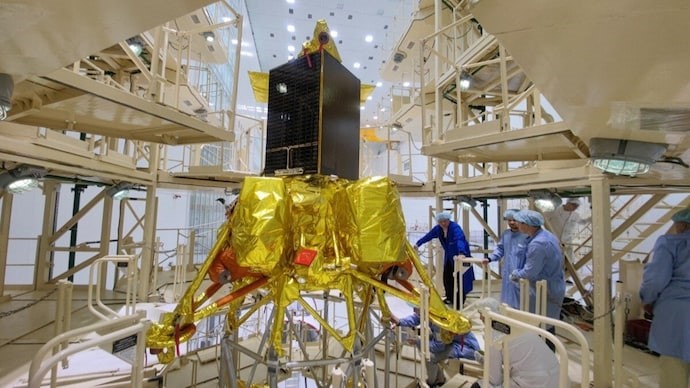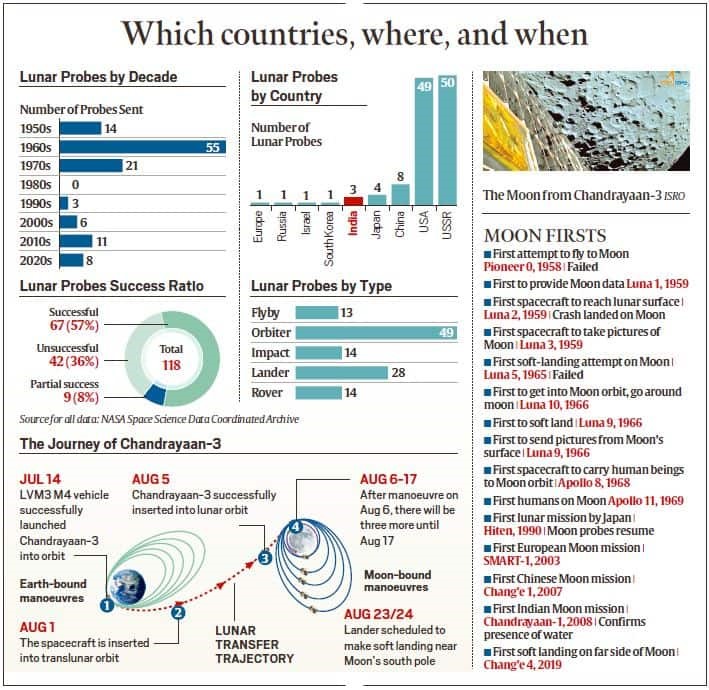
Disclaimer: Copyright infringement not intended.
Context
- Russia is poised to launch its first lunar landing spacecraft, Luna-25, on August 11, marking a significant step in its renewed lunar exploration efforts.
- This mission follows closely after India's Chandrayaan-3 lunar lander launch, reflecting a global interest in exploring the moon's south pole, potentially rich in resources like ice for future human habitation.
Details
Mission Overview
- Luna-25, launching from the Vostochny cosmodrome, aims to explore the moon's south pole region, believed to hold substantial ice deposits.
- Despite the proximity in timing, Roscosmos assures no interference between Luna-25 and Chandrayaan-3 missions due to different landing areas.
- The spacecraft, weighing 1.8 tons and carrying 31 kg of scientific equipment, will orbit the moon for five to seven days before descending to one of three potential landing sites near the pole.
.jpg)
Objectives and Challenges
- Luna-25's primary task is to collect rock samples from depths of up to 15 cm, testing for the presence of frozen water, a critical resource for potential lunar bases.
- The launch was initially slated for October 2021 but faced delays, eventually rescheduled for August 11, 2023.
- The European Space Agency's Pilot-D navigation camera, planned for testing on Luna-25, was disengaged from the project after Russia's Ukraine invasion in February 2022.
Significance for Russia
- Luna-25 revives Russia's lunar exploration program after nearly 50 years, marking a pivotal milestone in the country's space history.
- Despite challenges and setbacks, Russia's commitment to lunar exploration remains strong, as evidenced by the continued preparation for Luna-25's launch.
- The mission also underscores Russia's determination to contribute to scientific advancements and potential future lunar endeavors.
List of significant moon missions that have been conducted by various countries and space agencies up to the present date

Luna Program (Soviet Union/Russia)
- Luna 2 (1959): First human-made object to reach the moon.
- Luna 9 (1966): First successful soft landing on the moon, sent back images.
- Luna 16 (1970): Successfully returned lunar soil samples to Earth.
- Luna 24 (1972): Collected and returned lunar soil samples.
Apollo Program (USA)
- Apollo 11 (1969): First manned mission to land on the moon. Neil Armstrong and Buzz Aldrin walked on the lunar surface.
- Apollo 12, 14, 15, 16, 17: Follow-up missions with successful lunar landings, scientific experiments, and moonwalks.
Chang'e Program (China)
- Chang'e 3 (2013): Successfully landed a rover, Yutu, on the moon's surface.
- Chang'e 4 (2019): Landed on the far side of the moon and deployed the Yutu-2 rover.
- Chang'e 5 (2020): Collected lunar samples and returned them to Earth.
Lunar Reconnaissance Orbiter (USA)
- Launched in 2009 to study the moon's surface and gather data for future lunar missions.
Chandrayaan Program (India)
- Chandrayaan-1 (2008): Detected water molecules on the lunar surface and mapped the moon's composition.
- Chandrayaan-2 (2019): Orbiter, lander, and rover mission. Orbiter is operational and studying the moon.
- Chandrayaan-3 (2023): In-course towards moon.
Lunar Impact Missions:
- SMART-1 (European Space Agency) and Moon Impact Probe (India) were missions that deliberately impacted the moon to study its surface.
- Artemis Program (USA): Planned program aiming to return humans to the moon, with Artemis I being an upcoming uncrewed mission.
- Yutu-2 Rover (China): Part of the Chang'e 4 mission, this rover continues to explore the far side of the moon.
The Revival of Lunar Exploration: A New Era of Moon Missions
- The moon is set to witness a flurry of activity in the upcoming days as multiple spacecraft from different countries prepare to land on its surface.
- Chandrayaan-3 from India, Russia's Luna 25, and Japan's SLIM (Smart Lander for Investigating Moon) are all scheduled to touch down around the same time, potentially marking the first instance of three spacecraft operating simultaneously on the lunar surface.
Historical Perspective
- The 1950s and 1960s saw a surge in moon missions with 14 attempts within three years after the launch of the first spacecraft, Sputnik, by the Soviet Union.
- Several missions failed, but successes like Luna 3 in 1959, which sent back the first pictures of the lunar surface, stood out.
- The 1960s witnessed intense competition between the US and the Soviet Union, leading to the historic Apollo 11 mission in 1969 where humans first landed on the moon.
- A total of 55 moon missions were launched in the 1960s.
Resumption of Lunar Exploration
- Lunar missions paused after the Apollo missions of the 1970s, and there was a lack of missions in the 1980s.
- The 1990s marked a resurgence with Japan's mission, followed by participation from China, India, South Korea, and Israel.
- The motivations behind the current lunar missions differ significantly from the earlier era.
Distinct Objectives
- The Cold War rivalry drove the earlier missions, focusing on technological supremacy and psychological advantage.
- Current missions aim at exploration, utilization of lunar resources, and paving the way for deeper space exploration.
- Technological advancements have made lunar missions more cost-effective, efficient, and safer.
New Possibilities and Objectives
- The current missions consider the moon as a stepping stone for future space exploration, involving long-term stays and resource utilization.
- The possibility of setting up permanent lunar stations within a decade or two is being explored.
- The focus is on using lunar missions as a launchpad for journeys to distant celestial bodies.
Evolving Competition and Prospects
- The renewed interest in lunar exploration could lead to competition among countries for lunar territory and resources.
- The immediate objective is to establish a presence on the moon, with broader goals of extending human exploration deeper into space.

Conclusion
Luna-25's success will likely pave the way for further lunar missions and exploration activities, boosting Russia's profile in the global space community. Russia's renewed lunar ambitions highlight the enduring importance of lunar exploration in advancing scientific knowledge, resource utilization, and space exploration.
In conclusion, Russia's Luna-25 lunar lander mission holds great promise for advancing our understanding of the moon's south pole region and its potential for supporting future human activities. As nations collaborate and compete in exploring the cosmos, Luna-25 symbolizes Russia's commitment to embracing the challenges of space exploration and contributing to humanity's quest for knowledge beyond Earth.
The present era of lunar exploration reflects a shift from the competitive space race of the past to a collaborative effort with far-reaching objectives. The advancements in technology, understanding of the moon, and the quest for deeper space exploration have reshaped the motives behind lunar missions. The moon, once a symbol of Cold War rivalry, now represents a potential platform for humanity's broader exploration of the cosmos.
|
PRACTICE QUESTION
Q. Which of the following statements about significant moon missions is true?
a) Luna 2 was the first manned mission to land on the moon.
b) Chang'e 3 successfully collected lunar samples and returned them to Earth.
c) Apollo 11 was the first human-made object to reach the moon.
d) Chandrayaan-1 detected water molecules on the far side of the moon.
Answer: c)
|
https://www.indiatoday.in/science/chandrayaan-3/story/russia-to-launch-first-moon-lander-luna-25-days-ahead-of-planned-chandrayaan-3-landing-2417843-2023-08-08












